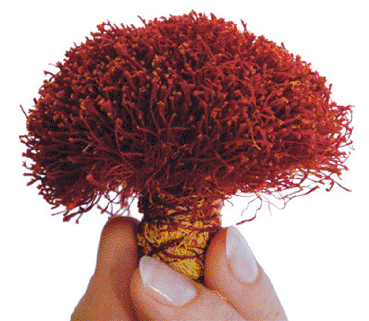If velvety olive oil is Spain's liquid gold, then surely saffron - with its 150 wonderful, aroma-yielding components - must be the country's solid gold?
 Not only does this precious spice bestow the beautiful sunny yellow color to such renowned Spanish dishes as paella, it also imparts positive health benefits on those who consume it, being a powerful antioxidant, as well as beneficial for your cholesterol, heart, and eye-sight. Some even say it beats Prozac for alleviating depression!
Not only does this precious spice bestow the beautiful sunny yellow color to such renowned Spanish dishes as paella, it also imparts positive health benefits on those who consume it, being a powerful antioxidant, as well as beneficial for your cholesterol, heart, and eye-sight. Some even say it beats Prozac for alleviating depression!
But, where does it come from?... How is it grown and harvested?... And, what are its culinary uses?...
Where Does Saffron Come From?
Saffron is, in fact, the hand-picked and hand-roasted deep, orangey-red stamen of a particular species of the little purple crocus flower - the crocus sativas.
Although its origins lie in Asia Minor, it was the Moors who introduced this precious condiment into Spain, when they conquered the land. The Moors called it "az-zafaran", which is similar to the Spanish word for saffron to-day - "azafrán".
Nowadays, around 70% of the World's saffron comes from the magical Spanish region of Castilla-La Mancha - a high plain in central Spain, famed not only for its extensive saffron fields, but also for its fairy-tale castles, romantic windmills... and, of course, Don Quijote.
Not only is Spain responsible for growing the lion's share of the World's saffron, it also undoubtedly produces the best, with the traditional, artisan-type harvesting being a true labor of love...
Growing and Harvesting Saffron
The scorching summers and harsh winters of La Mancha are ideal for growing and producing superb saffron. Towards the end of October, mile upon mile of saffron fields will suddenly burst into flower, resulting in a seemingly endless panorama of purple... quickly accompanied by bustling activity.
All the locals immediately rush to the fields. This is the moment they've been waiting for all year, and they know they must work quickly, otherwise the wonderful flavor will be lost. The entire harvesting period only lasts around 10 days, and so, the strenuous labor of love begins.
The men spend the day doubled-over, hand-picking each individual flower. These are then taken to the waiting women-folk who, with their more delicate fingers, pluck out the three stigmas which each little flower contains. The next step is a gentle roasting process and, for this, the stigmas are placed in a type of sieve over a low fire. Finally, the containers are proudly stamped "DO La Mancha", meaning "Denomination of Origin La Mancha", so that future customers can rest assured they're buying the best artisan saffron the World has to offer.
Once all the work is completed, they'll be much celebrating and rejoicing and, in the La Mancha villages, you'll find many local fiestas at this time of year.
Saffron in Cooking
When choosing saffron for adding color, aroma, and flavor to your dishes, plump for saffron threads rather than powder, for powdered saffron can easily be adulterated with cheaper Iranian saffrons, or with paprika.
Artisan-type saffron is undoubtedly king and, the deeper the color, the better. Just crumble a couple of strands into your dishes during cooking, along with stock or liquid, and the result will be not just a beautiful color, but also a superb fragrance and flavor. And, remember to store your saffron strands in an air-tight container, well away from the light.
Saffron is the World's most expensive spice, for you need 200 flowers just to make one gram. But, a little goes a long way and, when you're next enjoying a sunny-colored paella in Spain, spare a thought for all the hard work and loving care that went on in those vast, purple fields high up in La Mancha.
Comments:
| Comment | Date | User |
| it is called Kesar in Nepal | 6/9/2011 9:06:00 AM | Deepa |